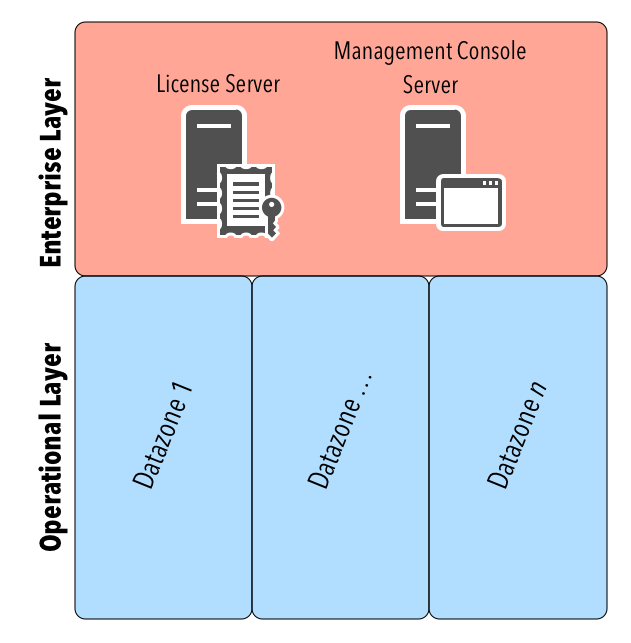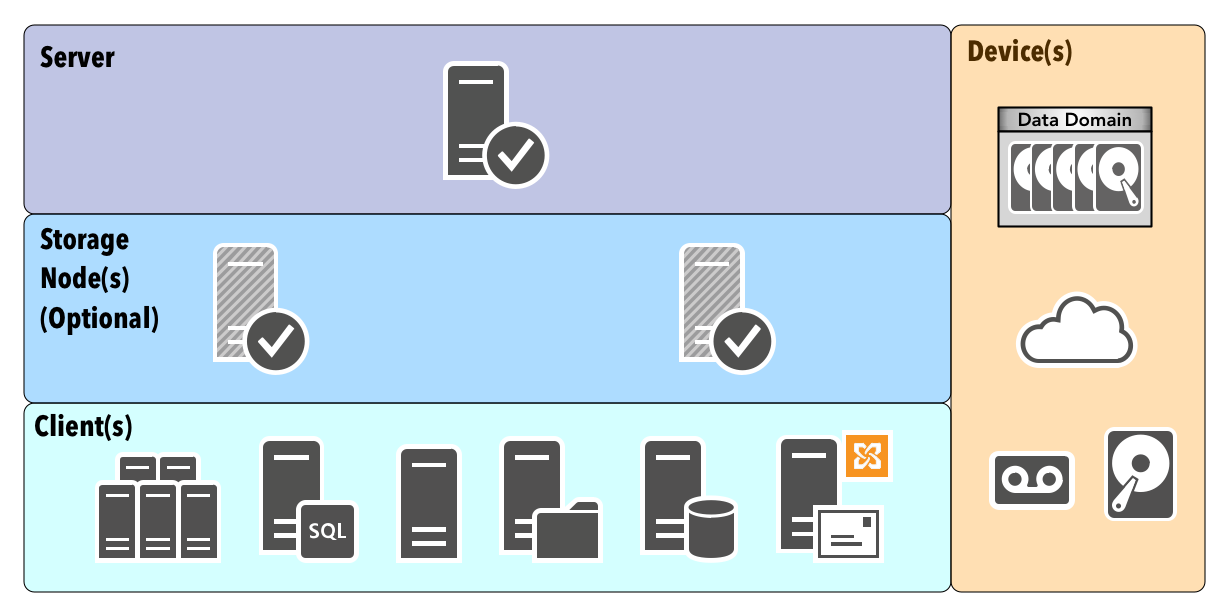With the NetWorker 9 architecture now almost 12 months old, I thought it was long past time I do a Basics post covering how the overall revised architecture for data protection with NetWorker functions.
There are two distinct layers of architecture I’ll cover off – Enterprise and Operational. In theory an entire NetWorker environment can be collapsed down to a single host – the NetWorker server, backing up to itself – but in practice we will typically see multiple hosts in an overall NetWorker environment, and as has been demonstrated by the regular NetWorker Usage Surveys, it’s not uncommon nowadays to see two or more NetWorker servers deployed in a business.
Enterprise Layer
The Enterprise Layer consists of the components that technically sit ‘above’ any individual NetWorker install within your environment, and can be depicted simply with the following diagram:
The key services that will typically be run within the Enterprise Layer are the NetWorker License Server, and the NetWorker Management Console Server (NMC Server). While NetWorker has previously had the option of running an independent license server, with NetWorker 9 this has been formalised, and the recommendation is now to run a single license server for all NetWorker environments within your business, unless network or security rules prevent this.
The License server can be used by a single NetWorker server, or if you’ve got multiple NetWorker servers, by each NetWorker server in your environment, allowing all licenses to be registered against a single host, reducing ‘relicensing’ requirements if NetWorker server details change, etc. This is a very light-weight server, and it’s quite common to the license services run concurrently on the same host as the NMC Server.
Like many applications, NetWorker has separated the GUI management from the core software functionality. This has multiple architectural advantages, such as:
- The GUI and the Server functionality can be developed with more agility
- The GUI can be used to administer multiple servers
- The functional load of providing GUI services does not impact the core Server functionality (i.e., providing backup and recovery services).
While you could, if you wanted to, deploy a NMC Server for each NetWorker Server, it’s by no means necessary, and so it’s reasonably common to see a single NMC Server deployed across multiple NetWorker servers. This allows centralised reporting, management and control for backup administrators and operators.
Operational Layer
At the operational layer we have what is defined as a NetWorker datazone. In fact, at the operational layer we can have as many datazones as is required by the business, all subordinate to the unified Enterprise Layer. In simple parlance, a NetWorker datazone is the collection of all hosts within your environment for which a single NetWorker server provides backup and recovery services. A high level view of a NetWorker datazone resembles the following:
The three key types of hosts within a NetWorker datazone are as follows:
- Server – A host that provides backup and recovery services (with all the associated management functions) for systems within your environment. There will either be (usually) a single NetWorker server in the datazone, or (in less common situations), a clustered pair of hosts acting as an active/passive NetWorker server.
- Client – Any system that has backup and recovery services managed by a NetWorker Server
- Storage Node – A host with access to one or more backup devices, either providing device mapping access to clients (I’ll get to that in a moment) or transferring backup/recovery to/from devices on behalf of clients. (A NetWorker server, by the way, can also function as a storage node.) A storage node can either be a full storage node, meaning it can perform those actions previously described for any number of clients, or a dedicated storage node, meaning it provides those services just to itself.
With such a long pedigree, NetWorker (as described above) is capable of running in a classic three-tier architecture – the server managing the overall environment with clients backing up to and recovering from storage nodes. However, NetWorker is equally able to ditch that legacy mode of operation and function without storage nodes thanks to the benefits of distributed deduplication in tightly integrated systems such as Data Domain and CloudBoost and ClientDirect. That being said, NetWorker still supports a broad range of device types ranging from simple tape through to purpose built backup appliances (Data Domain), Cloud targets, VTL and plain disk. (In fact, I remember years ago NetWorker actually supporting VHS as a tape format!)
ClientDirect, which I mentioned previously, is where clients can communicate directly with network accessible devices such as Data Domain deduplication storage. In these cases, both the NetWorker server and any storage node in the environment is removed from the data path – making for a highly efficient and scalable environment when distributed deduplciation is taking place. (For a more in-depth understanding of the architectural implications of Client Direct, I suggest you review this earlier post.)
Within this operational layer, I’ve drawn the devices off to the side for the following reasons:
- Devices can (and will) provide backup/recovery media to all layers in the NetWorker datazone – server, storage nodes (if deployed) and individual clients
- Devices that support appropriate multi-tenancy or partitioning can actually be shared between multiple NetWorker datazones. In years gone by you might have deployed a large tape library with two or more NetWorker servers accessing virtualised autochangers from it, and more recently it’s quite easy to have the same Data Domain system for instance being accessed by multiple NetWorker servers if you want to.
Wrapping Up
The NetWorker architecture has definitely grown since I started using it in 1996. Back then each datazone required completely independent licensing and management, using per-OS-type GUI interfaces or CLI, and it was a very flattened architecture – clients and the server only. Since then the architecture has grown to accommodate the changing business landscape. My largest NetWorker datazone in 1996 had approximately 50 clients in it – these days I have customers with well over 2,000 clients in a single datazone, and have colleagues with customers running even larger environments. As the NetWorker Usage Survey has shown, the number of datazones has also been growing as businesses merge, consolidate functions, and take advantage of simplified capacity based licensing schemes.
By necessity then, the architecture available to NetWorker has grown as well. Perhaps the most important architectural lesson for newcomers to NetWorker is understanding the difference between the enterprise layer and the operational layer (the individual datazones).
If you’ve got any questions on any of the above, drop me a line or add a comment and I’ll clarify in a subsequent post.

